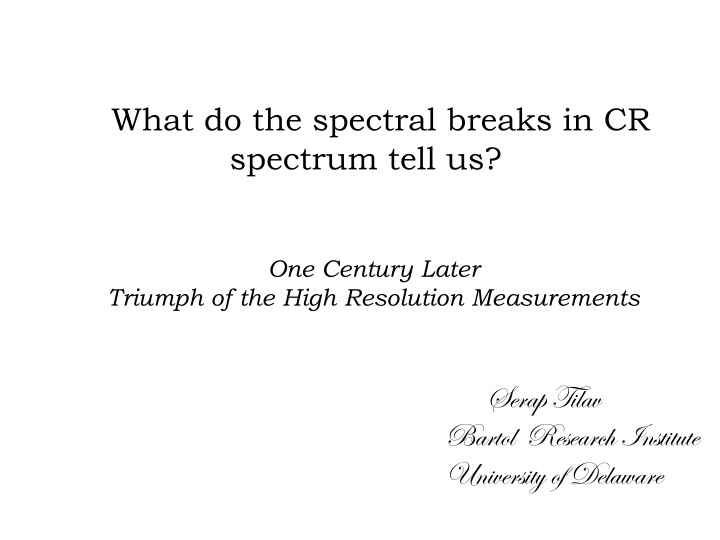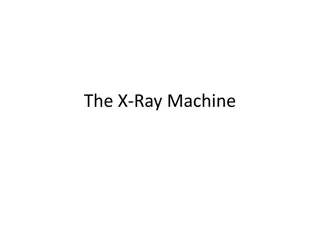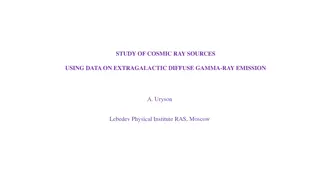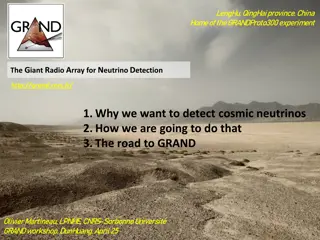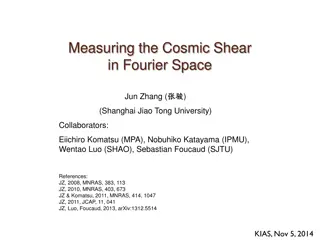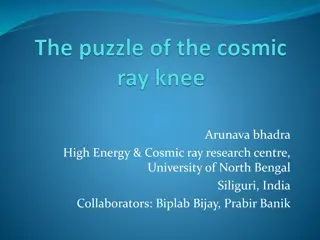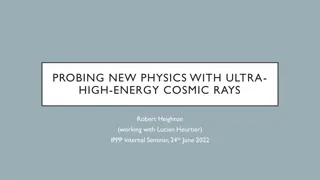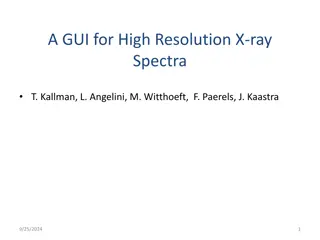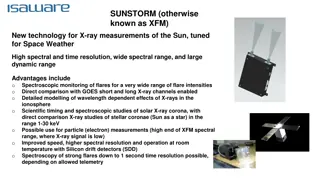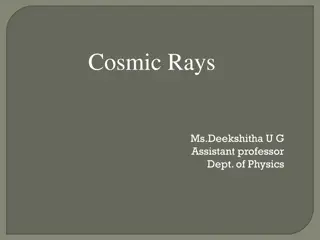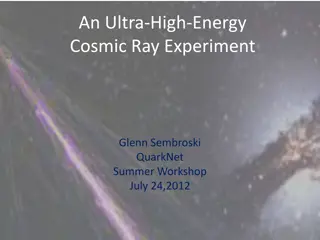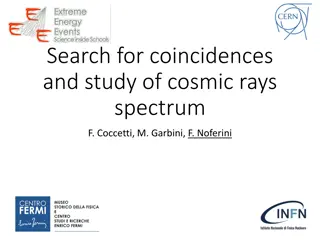Insights into Cosmic Ray Spectrum Breaks and Hardening after Centuries of High-Resolution Measurements
Spectral breaks in cosmic ray (CR) spectrum reveal rigidity-dependent behaviors, such as proton break at 240 GeV and remarkable hardening post-breaks. Various experiments like PAMELA, ATIC, CREAM II, and others showcase unique features and spectral indices, shedding light on CR composition and acceleration processes. The exploration of spectral indices of the hard component and all-particle spectrum from air shower experiments further enhances our understanding of CR phenomena.
Download Presentation

Please find below an Image/Link to download the presentation.
The content on the website is provided AS IS for your information and personal use only. It may not be sold, licensed, or shared on other websites without obtaining consent from the author.If you encounter any issues during the download, it is possible that the publisher has removed the file from their server.
You are allowed to download the files provided on this website for personal or commercial use, subject to the condition that they are used lawfully. All files are the property of their respective owners.
The content on the website is provided AS IS for your information and personal use only. It may not be sold, licensed, or shared on other websites without obtaining consent from the author.
E N D
Presentation Transcript
What do the spectral breaks in CR spectrum tell us? One Century Later Triumph of the High Resolution Measurements Serap Tilav Bartol Research Institute University of Delaware
When looked in detail the CR spectrum is not a boring simple power law Direct Measurements Satellite, Balloon Indirect Measurements Air Shower Experiments 3 2 -2 -1 -1 E dN/dE [GeV m sr s ] 10 10 10 10 10 10 2 3 4 5 6 7 10 2 10 3 10 4 Primary Energy, E [GeV] 10 5 10 6 CreamII Fe CreamII Si CreamII Mg CreamII O CreamII C CreamII He CreamII Proton Pamela He Pamela Proton 10 7 10 8 10 Auger 2013 TA 2013 IceTop-73 9 10 10 10 11
Proton Break 240 GeV He Break 2 X 240 = 480 GeV PAMELA /ATIC/ CREAM II reveal rigidity dependent spectral breaks and remarkable hardening after the breaks Fe Break 26 X 240 = 6240 GeV 4 10 ? ] -1 s -1 sr -2 m 1.6 dN/dE [GeV 2.6 E Perfect demonstration of Peters cycle: When protons accelerated to Epmax a nucleus with Ze will be accelerated up to Ezmax = Ze x R = Z x Epmax 3 10 Pamela Proton Pamela He where magnetic rigidity R = Pc/Ze CreamII Proton CreamII He CreamII C CreamII O CreamII Mg CreamII Si CreamII Fe 2 10 3 5 6 8 2 4 7 10 10 10 10 10 10 10 Primary Energy, E [GeV]
Spectral Indices of the hard component 3 2 10 -2 -1 -1 E dN/dE [GeV m 10 sr s ] 10 10 3 4 5 6 gHe=-2.58 CreamII Fe CreamII Si CreamII Mg CreamII O CreamII C CreamII He CreamII Proton Pamela He gFe=-2.29 Pamela Proton gProton=-2.67 10 2 Primary Energy, E [GeV] gO=-2.49 10 3 gSi=-2.37 10 4 10 5 10 6
All Particle Spectrum from Air Shower Experiments 4 10 ] -1 s -1 sr -2 m 1.6 dN/dE [GeV 2.6 E 3 10 HEGRA Casa-Mia Tibet III 2008 Kascade 2005 selection based on variety of techniques: cherenkov fluorescence scintillators muon counters Kascade-Grande 2012 IceTop-26 2 10 GAMMA 2008 Tunka-133 2011 AGASA 10 HiRes 1 HiRes 2 TA 2011 Auger 2011 1 6 8 9 10 7 11 10 10 10 10 10 10 Primary Energy, E [GeV] Gaisser s cross-calibrated spectrum: 5-20% energy shift to align features in the spectrum arXiv:1303.3565 [astro-ph.HE] 14 Mar 2013 Gaisser , Stanev ,Tilav
The mean logarithmic mass <lnA> fromAir Shower Experiments IC40/IT40 Kascade Tunka-133 HiResMia HiRes Auger TA 4.5 IC40/IT40, Tunka-133, Auger are published by the experiments 4 3.5 3 Kascade/HiRes/TA do not provide <lnA> <lnA> 2.5 2 1.5 Use derived data by Kampert and Unger analysis K. H. Kampert and M. Unger, Astropart. Phys., 2012, 35(10): 660 1 0.5 0 6 8 9 10 7 11 10 10 10 10 10 10 Primary Energy, E [GeV]
4 10 Fit the combined spectrum with Gaisser s formulation of Peters cycle ] -1 s -1 sr -2 m 1.6 dN/dE [GeV 2.6 E 3 10 - E EdN dE i E-gie = ZiEcutoff Ai 2 10 HEGRA (0.9*E) Casa-Mia (1.2*E) Tibet III 2008 (1.05*E) Kascade 2005 (0.95*E) Kascade-Grande 2012 (1.05*E) IceTop-26 (0.95*E) GAMMA 2008 Tunka-133 2011 AGASA (0.7*E) HiRes 1 HiRes 2 TA 2011 Auger 2011 (1.22*E) elements Pamela Proton Pamela He CreamII Proton A g Z *Ecutoff(PeV) Amplitude spectral index Z dependent cutoff energy CreamII He CreamII C 10 CreamII O CreamII Mg CreamII Si CreamII Fe 1 3 5 6 8 9 10 2 4 7 11 10 10 10 10 10 10 10 10 10 10 Primary Energy, E [GeV]
7 10 Proton He C O Fe ] -1 s -1 sr -2 m 2 dN/dE [GeV 3 E 6 10 5 10 4 10 3 5 6 8 9 10 2 4 7 11 10 10 10 10 10 10 10 10 10 10 Primary Energy, E [GeV] Amplitudes and indexes of all elements are defined by the CreamII data. Only the cutoffs need to be fit. Amplitudes, integral indexes, cutoff energies Fe spectrum is the key to the whole puzzle. Proton: 7800, 1.66, 400 TeV He : 2800, 1.58, 2x400 TeV C : 110, 1.4, 6x400TeV 0 : 140, 1.4, 8x400 TeV Fe : 25, 1.2, 26x400 TeV The Cream Fe data, when extended with the same index up to an energy where it makes 100% of the all particle spectrum, defines the maximum cut off energy for Fe. This point turns out to be 26*400 TeV = 10.4 PeV. This means proton cuts off at 400 TeV
7 10 Proton He C O Fe ] -1 s -1 sr -2 m 2 dN/dE [GeV 3 E However 6 10 <lnA> data tells us the knee is not 100% Fe. 5 10 Since the amplitudes are locked by the Cream data, the only way to fit <lnA> is to bring the cutoff energy down 4 10 3 5 6 8 9 10 2 4 7 11 10 10 10 10 10 10 10 10 10 10 Primary Energy, E [GeV] 4.5 IC40/IT40 Kascade Tunka-133 HiResMia HiRes Auger TA and fill the rest with light elements of a new Peters cycle (a new population of particles) 4 3.5 3 <lnA> 2.5 2 1.5 1 0.5 0 6 8 9 10 7 11 10 10 10 10 10 10 Primary Energy, E [GeV]
== Method == Make a template for Population 2 similar to Population 1 7 10 Proton_total He_total C_total O_total Fe_total ] -1 s -1 sr -2 m 2 dN/dE [GeV 3 E Scan for cutoff energy by sliding the template until best agreement with lnA is reached. 6 10 5 10 The cutoff energies defined by the proton under the first iron (according to lnA) and the second iron not to overproduce the spectrum around 100 PeV. 4 10 3 5 6 8 9 10 2 4 7 11 10 10 10 10 10 10 10 10 10 10 Primary Energy, E [GeV] 4.5 Initially the indices are same as Pop1. Next, the amplitudes are adjusted by fitting Pop1+Pop2 IC40/IT40 Kascade Tunka-133 HiResMia HiRes Auger TA 4 3.5 3 <lnA> 2.5 Pop1 cutoff energy comes down from 400 TeV to 120 TeV, and Pop2 indices are adjusted, amplitudes are fitted again. 2 1.5 1 0.5 0 6 8 9 10 7 11 10 10 10 10 10 10 Primary Energy, E [GeV]
Population 1 alone after Population 2 injected 7 10 Proton He ] -1 s -1 sr -2 m 2 dN/dE [GeV 3 E in order to accommodate Pop2 overlapping with Pop1, the cutoff energy of Pop1 comes down to 120 TeV after the fits. C O Fe 6 10 5 10 Note: there is yet another population before Pop1. When data below the breaks are fitted with another population Pop1 fit parameters change slightly. The biggest change is the spectral indexes for Proton and He and90 TeV < E1cutoff < 150 TeV 4 10 3 5 6 8 9 10 2 4 7 11 10 10 10 10 10 10 10 10 10 10 Primary Energy, E [GeV] Population 2 alone 7 10 Proton He ] -1 s -1 sr -2 m 2 dN/dE [GeV 3 E Pop2 cutoff at 4 PeV gives the overall best fit. (Fe cuts off at 26*4= 104 PeV) C O Fe 6 10 Note: When Pop0 is fitted this cutoff changes along with the Pop1 cutoff. 5 10 3.5 PeV < E2cutoff < 4.5 PeV 4 10 3 5 6 8 9 10 2 4 7 11 10 10 10 10 10 10 10 10 10 10 Primary Energy, E [GeV]
Proceed with the same method to inject another Peters cycle as Population 3 The best fit is achieved with only Proton and Iron making up the spectrum, other elements are reduced to negligible amounts. However, a gap is left between Pop2 and Pop3 and lnA is not described well. It was necessary to include the ultraheavy element groups as inspired by the lowE CR measurements without ultraheavy nuclei with ultraheavy nuclei 7 10 7 10 Proton_total He_total C_total O_total Fe_total Z=53 group Z=80 group Proton_total ] -1 s -1 sr -2 m 2 dN/dE [GeV 3 E ] -1 s -1 sr -2 m 2 dN/dE [GeV 3 E He_total C_total 6 6 10 O_total 10 Fe_total 5 5 10 10 4 10 4 10 3 5 6 8 9 10 2 4 7 11 3 5 6 8 9 10 2 4 7 11 10 10 10 10 10 10 10 10 10 10 10 10 10 10 10 10 10 10 10 10 Primary Energy, E [GeV] Primary Energy, E [GeV] 4.5 4.5 IC40/IT40 Kascade Tunka-133 HiResMia HiRes Auger TA IC40/IT40 Kascade Tunka-133 HiResMia HiRes Auger TA 4 4 3.5 3.5 3 3 <lnA> 2.5 <lnA> 2.5 2 2 1.5 1.5 1 1 0.5 0.5 0 0 6 8 9 10 7 11 10 10 10 10 10 10 6 8 9 10 7 11 10 10 10 10 10 10 Primary Energy, E [GeV] Primary Energy, E [GeV]
There has to be another proton under the iron bump to bring <lnA> down This extra proton has a much harder spectrum with E-2.2 and cuts off around 22 EeV extra-galactic proton cutting off due to GZK? 4.5 IC40/IT40 Kascade 4 Tunka-133 HiResMia 3.5 HiRes Auger 3 TA <lnA> 2.5 2 1.5 1 0.5 0 6 8 9 10 7 11 10 10 10 10 10 10 Primary Energy, E [GeV]
7 10 7 10 Proton_total He_total C_total O_total Fe_total Z=53 group Z=80 group Proton_total He_total C_total O_total Fe_total Z=53 group Z=80 group ] -1 s -1 sr -2 m 2 dN/dE [GeV 3 E ] -1 s -1 sr -2 m 2 dN/dE [GeV 3 E 6 10 6 10 5 10 5 10 4 10 4 3 5 6 8 9 10 10 2 4 7 11 10 10 10 10 10 10 10 10 10 10 3 5 6 8 9 10 2 4 7 11 10 10 10 10 10 10 10 10 10 10 Primary Energy, E [GeV] Primary Energy, E [GeV] 4.5 4.5 IC40/IT40 Kascade Tunka-133 HiResMia HiRes Auger TA IC40/IT40 Kascade Tunka-133 HiResMia HiRes Auger TA 4 4 3.5 3.5 3 3 <lnA> 2.5 <lnA> 2.5 2 2 1.5 1.5 1 1 0.5 0.5 0 0 6 8 9 10 7 11 10 10 10 10 10 10 6 8 9 10 7 11 10 10 10 10 10 10 Primary Energy, E [GeV] Primary Energy, E [GeV] Pop3 for TA/HiRes Pop3 for Auger Pop4 Proton makes up most of the bump. Pop3 Fe + Pop4 Proton make up the bump. 14
Proton_total He_total C_total O_total Fe_total Z=53 group Z=80 group 4 10 ] -1 s -1 sr -2 m 1.6 dN/dE [GeV 2.6 E 3 10 2 10 Pamela Proton Pamela He CreamII Proton CreamII He CreamII C CreamII O CreamII Mg 10 CreamII Si CreamII Fe 1 3 5 6 8 9 10 4 7 11 10 10 10 10 10 10 10 10 10 Primary Energy, E [GeV] At least 3 Populations of Peters Cycle are needed to explain the spectrum and <lnA> from ~ 200 GeV up to 200 EeV Population 1: The classical supernova cutting around 100 TeV Population 2: Galactic PeVatron to produce the IceCube neutrinos Population 3: Another powerful source superposed with extra-galactic protons cutting by GZK Spectral index of 2.7 is the superposition of much harder indexes of elements
